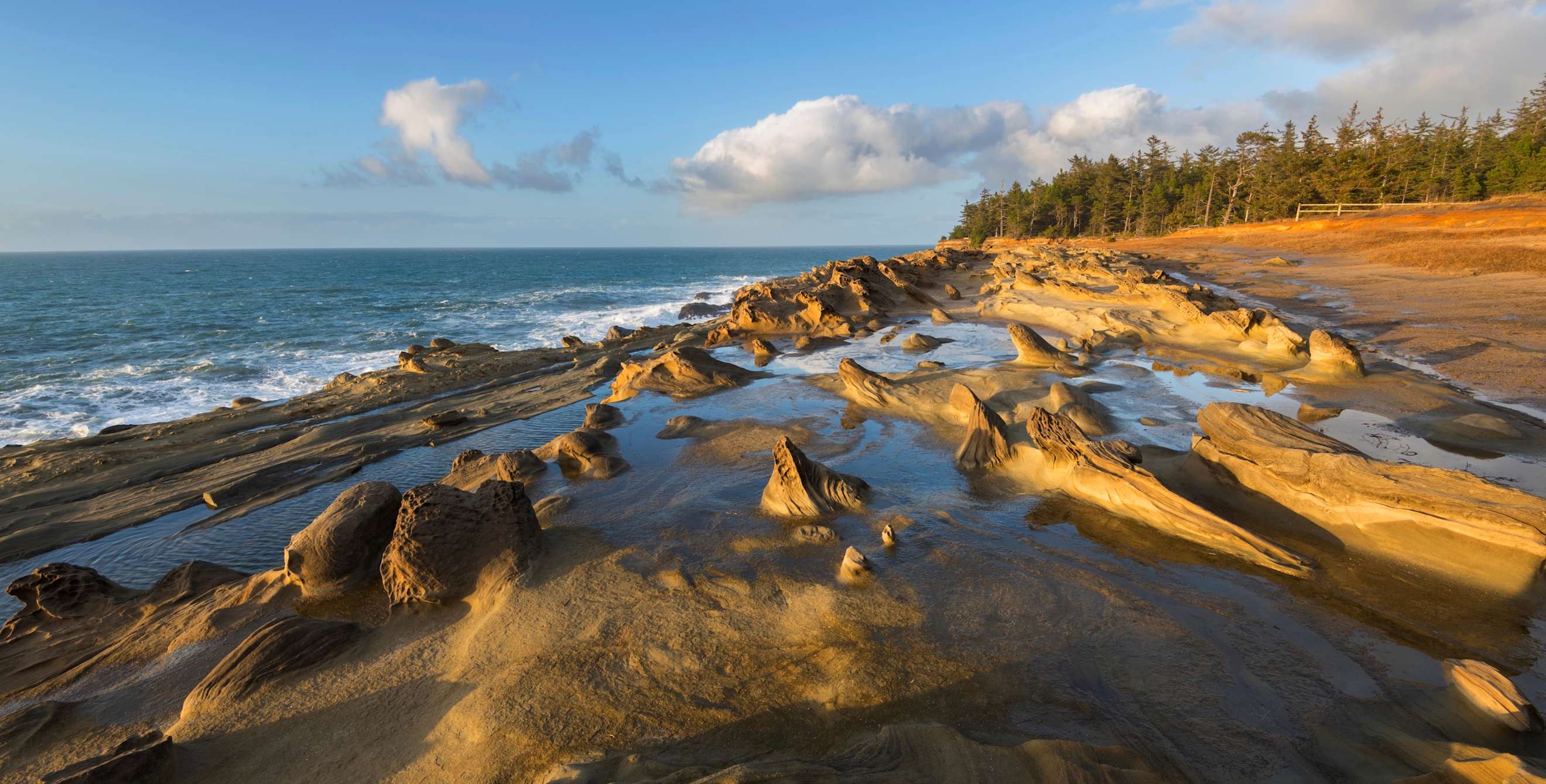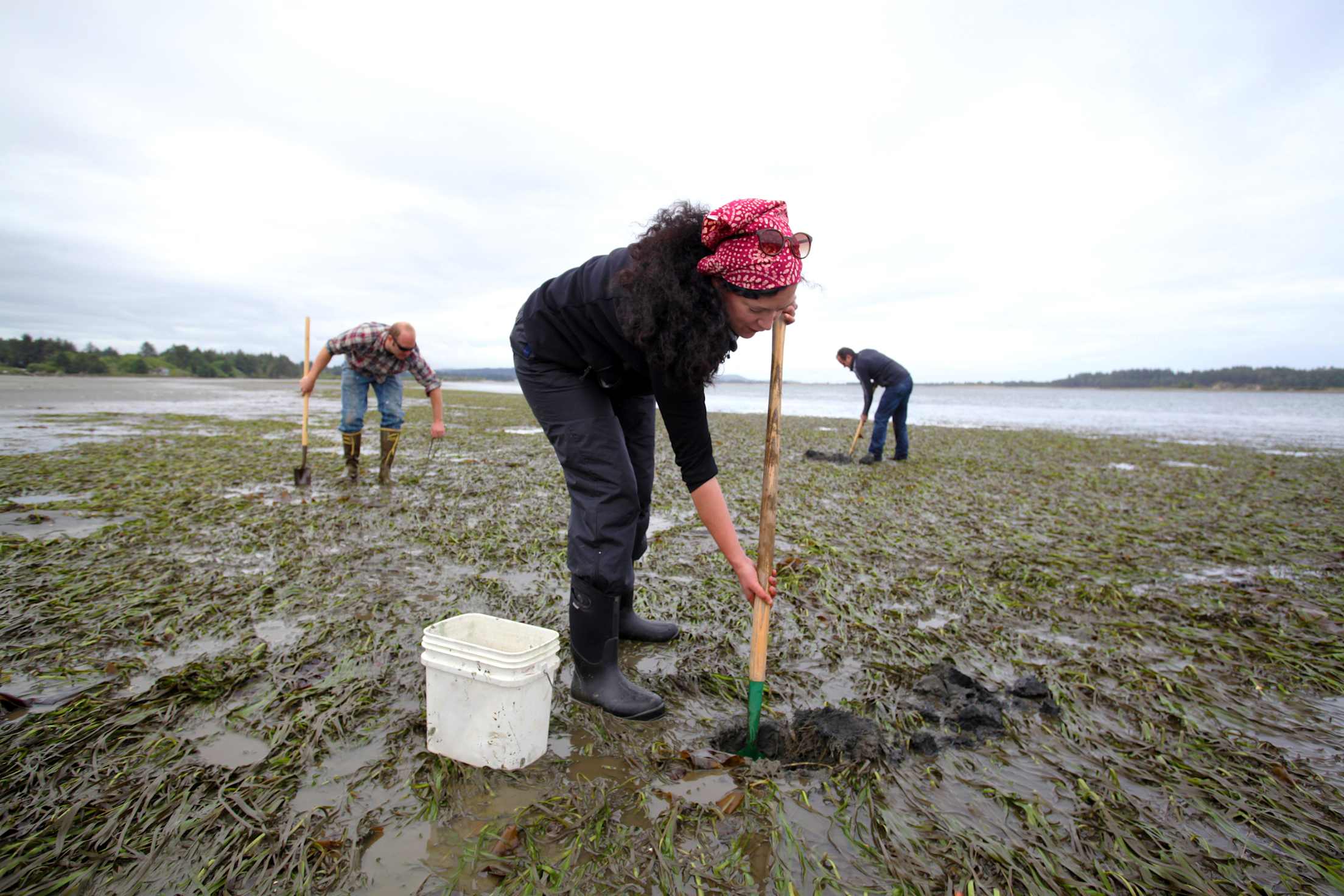
Charleston, Oregon: Crabs & Clams on Coos Bay
Natural beauty and fresh shellfish: Get ready to add Oregon's Coos Bay to your bucket list.

The marina in Charleston, Oregon, is quiet today with just a few mariners in the boatyard and some crabbers hoping the seals don't mess with their traps. Local crabber and mariner Jodi LeDoux says hi to them all as I follow her down the docks. "Now what we're looking for are these little buttons just swimming along," she says, her eyes fixed on the green water below. "We'll get into them, I promise."
Swimming buttons? Suddenly I see them. Hundreds of translucent pea-size . . . creatures . . . dart below the surface. LeDoux catches one and plops it into my palm. It has toy pincers and freakish blue eyes set in a see-through face that only an alien could love.
"A baby Dungeness crab," she says. "Kind of neat, huh?"
More like outrageously neat, but then again, this part of the Oregon coast is full of marvels.
Charleston is one of three neighboring communities on Coos Bay, a 15-mile boomerang of calm, clam-filtered water that also wraps around the towns of Coos Bay and North Bend. Roughly 125 miles southwest of Eugene, Oregon's Bay Area, as it is sometimes called, is the deepest port between Seattle and San Francisco. It's also the most populated area of that stretch of the coast, with about 30,000 people in all, but don't let the superlative fool you. These burgs sit a few miles inland and light-years away from the polished attractions of Newport or Florence. And while it can be tough to find a balcony with an ocean view or a quaint cobblestoned street, the region abounds in a rarity on the often crowded, touristy coast: an affordable chance to play in the git-'er-done world of muck boots and tugboats, with a backdrop of the most incredible coastline you've never seen.
"You ask most people about Charleston, and they go, 'Where's Charleston?'" says Mike Seidel, who regularly drives over from Bend to crab from the docks for fun. "I suppose that's why we like it."
It is the water, of course, that seasons everything here. Millions of pounds of seafood leave the port for restaurants all over the world every year, but plenty is left for the locals.
You can go crabbing at the Empire docks on the west side of the town of Coos Bay. As you crack the claws at picnic tables near the docks, a harbor seal named Flash might come in close to investigate. Pacific Charter Services in Coos Bay can help you reel in tuna and salmon from the open ocean on a sportfishing trip. Don't feel like landing your own? The Dover sole falls off the fork at the Portside in Charleston, and the chowder at Sharkbite's Seafood Café in Coos Bay is off the hook.
More attractions await discovery, like so many butter clams in the sand. Hidden just past Charleston, South Slough National Estuarine Research Reserve, established in 1974 as the first site of its kind, showcases marshes brimming with eelgrass and egrets. Although a native Oregonian, I had never heard of the area's crown jewel, Shore Acres State Park, once part of the estate of timber baron Louis Simpson, who founded North Bend in 1903. Marvel at the park's hundreds of dahlias that bloom through mid-October, find a perfect overlook for spying on sea lions at Simpson Reef, or hike to views of the Cape Arago Lighthouse. There, great swirls of sandstone with knotty mineral deposits twist out of the earth like 45-million-year-old taffy rounded by gigantic waves. Samuel Boardman, the father of Oregon's state park system, called the vision of this coastline "the Rembrandt of the sea."
Back on the dock, LeDoux tosses the tiny crab back into the water, lends me a shovel and a bucket, and tells me where to dig. I drive out to the beach, park, and wander out in my muck boots. Soon I'm into some clams, my bucket filling rapidly. The tide is low and the air is silver with fog that blurs the edges of everything. Mudflats by Monet, I suppose.

An Introduction to Clamming and Crabbing
Step into your muck boots or grab a trap—the tidal flats, docks, and charter boats around Coos Bay offer easy access to prime clamming and crabbing that even beginners can enjoy. Use these resources to find the freshest shellfish and learn how to tell your empires from your Martha Washingtons.
You'll need to buy a state shellfish license, which covers clams and crabs, and then learn how many—and what sizes—you can keep. Do both at an Oregon Department of Fish and Wildlife office or on the agency's website: dfw.state.or.us. Check for health advisories or closures with the Oregon Department of Agriculture: oregon.gov/oda.
For clamming, each digger needs rubber muck boots, a bucket, and a long, sturdy round-nose shovel. A clam gun is also good for collecting small guys. Crabbing requires a ring net and bait—such as poultry legs or fish heads—and a bucket.
There are two places that locals know are particularly good for clamming. One is The South Slough, just south of the Charleston bridge, a popular spot for butter clams (aka Martha Washingtons) at very low tide. From Cape Arago Highway, turn south on Roosevelt Boulevard near the High Tide Cafe and park at the end of the road where the mudflats begin. Another option is Fossil Point and Pigeon Point, on Cape Arago Highway just north of Charleston, which offers numerous spots. Sandy areas are good for gapers and cockles. More gravelly bars hold butters and littlenecks.
Crabbers will usually have good luck at the very end of D dock, where the Charleston Marina leans out over water salty enough to attract big, clumsy Dungeness crabs as well as small, feisty red rock crabs. The Empire docks just west of the intersection of South Empire Boulevard and Newmark Avenue in the town of Coos Bay are another accessible spot. For a big catch, your best bet is to hire a boat and a captain. The pots go down and, while the crabs take the bait, you take in views of the bay.